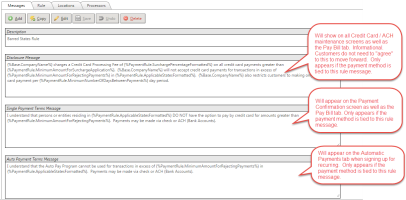Payment Rules Admin
Management of Payment Rule Messages can be found by going to Utilities -->System Administration --> Payments --> Payment Rules and then use the Messages tab. Once a Message is setup and tied to a Processor via the Processors tab, it will automatically be implemented for accounts using that Processor.
Payment Rule messages can support replaceable values such as Company Name, Applicable States, Minimum Amounts defined in the Payment Rules defined above, etc. that can help customize the Terms and other messages for each client. Replaceable values should be enclosed in {% %} in order to work properly. Please work with your Account Manager for a complete list of values that can be used.
The Advanced Payment Rule settings allow clients to take the messages one step further and also define rules that can be applied to the Credit Card and / or ACH transactions. These rules can have a variety of applications and take into account several parameters before allowing payments of certain types or amounts to be made, limit the amount a user can pay via CC or ACH, as well as apply percentage surcharges if the criteria is met. Each item is designed to work in conjunction with other settings in order to apply the payment rules.
For example, many credit card processors impose fees for transactions, particularly if they are of a larger amount. Some states however, may not allow the fee to be applied despite that credit card processor will still apply a fee. To best support this scenario, two rules would likely be setup. 1 -A Payment rule that applies a 3% fee on any payments over a minimum threshold. 2 - A Payment rule that would not allow payments greater than a specific threshold within certain states that don't allow the fee. This would prevent customers from making payment over the minimum, but only in locations that don't allow the fee.
These two rules combined would allow the client to impose a 3% surcharge on payments of their choosing and also prevent payments that may not be able to have the fee recouped due to state regulations.
There are many different ways to configure the Payment Rules to meet each Client's needs. Items that can be configured:
- Surcharge Percentage - Percentage point that should be applied to the total payment amount being requested. See below on how this surcharge is handled and applied to the account.
- Minimum Amount for Surcharge Application - Minimum payment amount that will be considered for a surcharge, if defined. Anything equal to or greater than this amount will have the surcharge applied (pending any other rules defined).
- Minimum Number of Days between Payments - Allows restrictions to be made on the number of payments that can be made during a time period. This can be useful if the Minimum Amount for Surcharge Application is enforced to prevent customers from making multiple, below minimum amount payments within the payment period to avoid surcharges.
- Minimum Amount for Rejecting Payments - Allows payments over a certain amount to be prevented. Again, this can be combined with the other payment rules above, i.e., Applicable states, to limit large payments in states that may not allow a surcharge to be applied.
Management of these Payment Rules can be found by going to Utilities -->System Administration --> Payments --> Payment Rules and using the Rules tab when setting up a new Payment Rule. Note: This tab is only enabled for clients that have arranged for this module/service. Please be sure to contact your Account Manager for more information.
Implementing Payment Rules & Messages
Applicable Locations - Once a Payment Messages and/or Rule are setup, they can then be configured to apply to only certain Locations (Country/State) if necessary. Management of these Payment Rule Locations can be found by going to Utilities -->System Administration --> Payments --> Payment Rules and using the Locations tab when setting up a new Payment Rule.
Payment Processors - The last and most important step in implementing a Payment Rule is to apply it to a Payment Processor. Since Payment Processing is driven by and underlying Payment Processor, Payment Rules must be linked to the appropriate Payment Processor so they are applied to the correct accounts. This allows for multiple rules if multiple processors exist, or the flexibility to have different messages and rules based on Credit Card vs. ACH.


